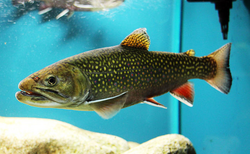Difference between revisions of "Brook trout"
AlexBot2004 (talk | contribs) m |
AlexBot2004 (talk | contribs) m |
||
| Line 11: | Line 11: | ||
|ru-name= N/A | |ru-name= N/A | ||
|image= Brook Trout PG Field Sprite.png | |image= Brook Trout PG Field Sprite.png | ||
| + | |imagesize= 46px | ||
|scientific name= Salvelinus fontinalis | |scientific name= Salvelinus fontinalis | ||
|family= Salmonidae | |family= Salmonidae | ||
| Line 16: | Line 17: | ||
|timeday= All day | |timeday= All day | ||
|found= [[Lake]] | |found= [[Lake]] | ||
| − | |||
|shadow= Small-Medium | |shadow= Small-Medium | ||
|rarity= Uncommon | |rarity= Uncommon | ||
Revision as of 14:03, February 4, 2021
The Brook Trout is type of freshwater fish in the Animal Crossing series introduced in Animal Crossing. It replaces the Japan-exclusive Herabuna from Doubutsu no Mori and Doubutsu no Mori+.
Catch details
In Animal Crossing
Donating to the museum
Blathers will give a speech on the brook trout when the brook trout is donated to the museum:
In Animal Crossing
"Even run-of-the-mill, common fish are valuable resources, you see. All part of the grand tapestry, wot! We will take excellent care of this fellow, oh yes. You can rest assured. Excellent care, indeed."
Gallery
Real-world information
This fish lives in eastern North America, in lakes, rivers, and ponds at a high altitude. Some of these fish stray out to sea, but, unlike the salmon, they will not stray far from the river mouth. Despite being named a trout, it is genetically more closely related to the char. The brook trout has a dark green to brown color, with a distinctive marbled pattern of lighter shades across the flanks and back and extending at least to the dorsal fin, and often to the tail. A distinctive sprinkling of red dots, surrounded by blue halos, occurs along the flanks.
More information on this topic is available at Wikipedia.
| Fish | |||||||||||||||||||||
|---|---|---|---|---|---|---|---|---|---|---|---|---|---|---|---|---|---|---|---|---|---|
| |||||||||||||||||||||
